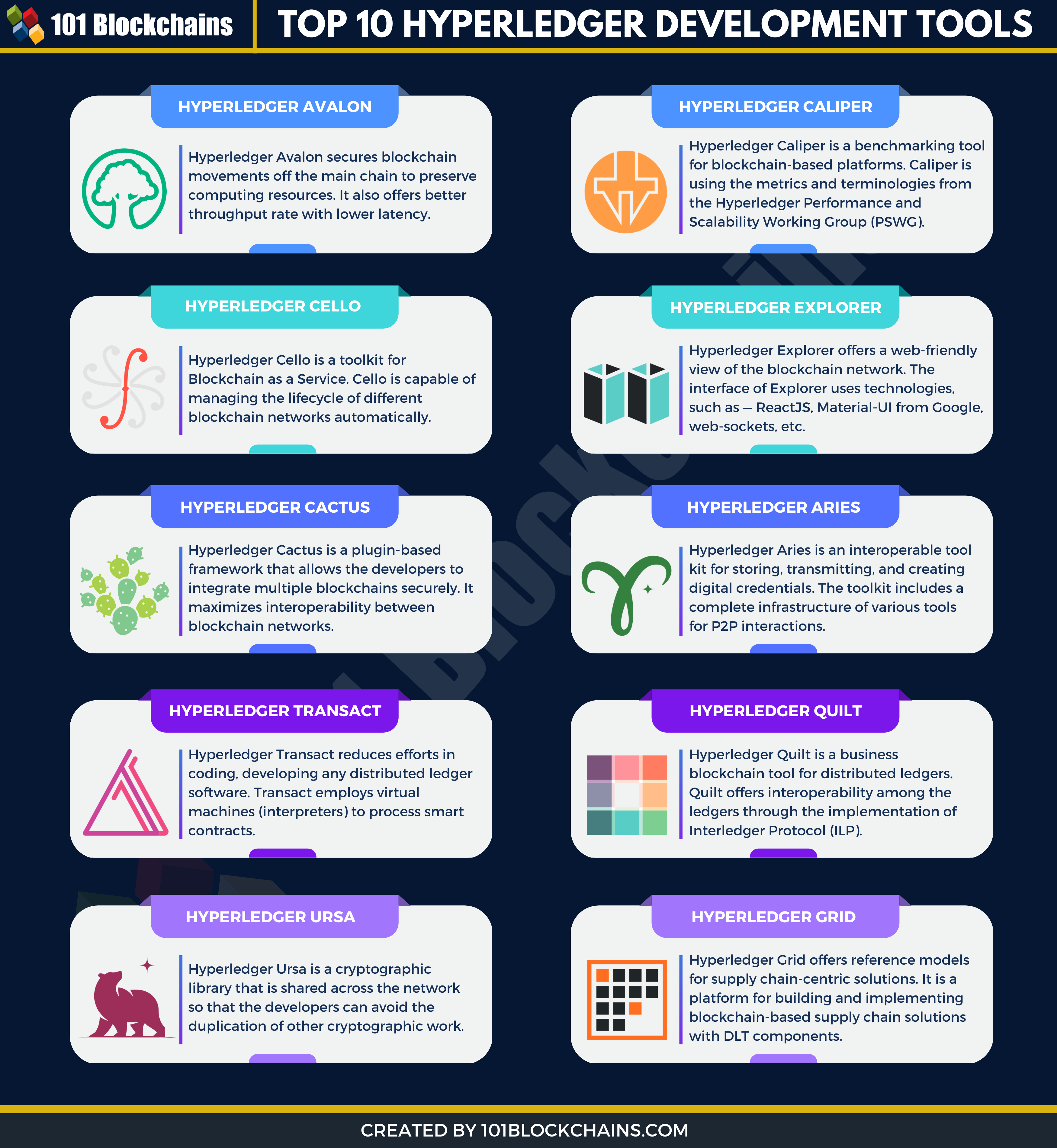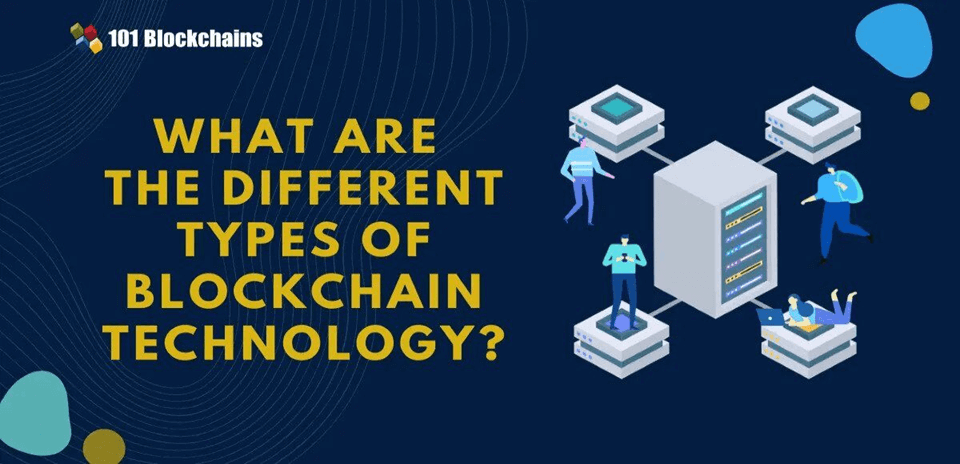Learn how blockchain truly works, master key definitions, and uncover what makes smart contracts so "smart." Dive into the fundamentals, gain valuable insights, and start your blockchain journey today!

- Reviews
Hasib Anwar
- on June 01, 2021
Top 10 Hyperledger Development Tools 2022
This guide offers a comprehensive analysis of all Hyperledger development tools, including — their core technological components, motivation, use cases, and scopes.
Hyperledger is clearly one of the leaders in the blockchain community, driven towards providing enterprise-grade blockchain solutions. Initiated by The Linux Foundation, this open-source community is addressing the scopes and opportunities for blockchain implementation in the enterprise ecosystem.
It’s true that most of us are only familiar with the popular Hyperledger framework tools, such as — Hyperledger Fabric, Sawtooth, or Indy. The developers need to have a better command of the Hyperledger development tools. Furthermore, Hyperledger has a total of ten full-fledged tools and libraries in the incubation phase.
As you can guess, today, we would discuss the best Hyperledger development tools, their underlying technological aspects, and use cases.
Excited to learn the basic and advanced concepts of Hyperledger Fabric? Enroll Now in Getting Started with Hyperledger Fabric Course
Top Hyperledger Development Tools
Please include attribution to 101blockchains.com with this graphic. <a href='https://101blockchains.com/blockchain-infographics/'> <img src="https://101blockchains.com/wp-content/uploads/2021/05/10-best-ethereum-development-tools.png" alt="10 best ethereum development tools" border='0' /> </a>
Hyperledger has a total of five best Hyperledger development tools in the incubation phase. They are —
- Avalon
- Caliper
- Cello
- Explorer
- Cactus
Hyperledger Composer was another one of the top Hyperledger development tools. But it got deprecated in August 2019 due to inactivity. Now, the developers suggest using Hyperledger Fabric v1.4+ that includes most of the features of Composer.
Here are the details of the five active tools —
Hyperledger Avalon

Avalon is currently among the most popular Hyperledger development tools. Why? It addresses two of the major concerns for enterprise blockchain developers — scalability and confidentiality.
The traditional blockchain development efforts implement data and validation logics directly on the mainnet, for every transaction on every node. This legacy approach ensures the integrity of the blockchain network but jeopardizes performance and confidentiality.
The Enterprise Ethereum Alliance (EEA) was first to address this issue and published Trusted Compute Specifications. Furthermore, Hyperledger then extended the core idea of EEA by developing the Trusted Compute Framework (TCF). Later, this TCF became a full-fledged Hyperledger project and got the official name — Hyperledger Avalon.
The core fundamental of Avalon is to offer a framework to develop blockchain solutions “off-chain” to answer the privacy and performance threats.
As a result, enterprise projects will get the benefit of —
- Better throughput rate with lower latency
- Significantly improved transactional privacy
- Data validation for the data generated on off-chain
In the traditional development approach, the integrity and confidentiality of the projects were in a trade-off relationship. Also, this meant that participants had to sacrifice integrity and resilience to gain better performance and improved confidentiality.
Hyperledger Avalon solves this issue by incorporating three Trusted Compute (TC) components —
- Zero Knowledge Proof (ZKP)
- Multi-Party Compute (MPC)
- Trusted Execution Environments (TEE)
Another aspect of Hyperledger Avalon is its collaborative features. Rather than competing, it collaborates and extends the specifications proposed by EEA. In fact, Avalon is the connecting point for Hyperledger, EEA, and cloud services.
As a result, Avalon became the most heavily sponsored project by Hyperledger.
Curious to know more about Ethereum vs Hyperledger Fabric? Here’s a guide that will help you find all the differences between them.
Hyperledger Caliper

Not every blockchain solution can perform at its maximum efficiency. The efficiency and performance will always depend on various external factors and use cases. That being said, there was no benchmark tool available to address this issue.
Until Hyperledger Caliper!
Caliper addresses the three major reasons why the current blockchain development efforts need a performance benchmark tool. Here they are —
- Unavailability of the source codes of the existing performance reports that questions the validation for evaluations.
- The lack of a defined set of performance indicators.
- No viable means are available to benchmark the use cases suitable for a particular blockchain.
Caliper is using the metrics and terminologies from the Hyperledger Performance and Scalability Working Group (PSWG). In fact, all of these possibilities and scopes have made many enterprise companies interested in Hyperledger caliper already. Developers from IBM, Huawei, Oracle, Hyperchain, Bitwise, and Soramitsu are working and contributing to this project.
Hyperledger Caliper aims to quantify the performance of particular blockchain implementation, based on a predefined set of use cases. Right now, Caliper uses four performance indicators to benchmark the blockchain solutions against predefined use cases —
- Transaction and Read throughout rate (transactions/reads per second)
- Transaction and Read latency, using three quantifiers — minimum, maximum, and average
- Resource consumption (CPU usage, memory usage, network input/output, etc.)
- Success rate — a unique benchmark parameter developed by Caliper
Initially, Caliper was only aimed at the top Hyperledger frameworks tools — Fabric, Sawtooth, and Iroha. But currently, Caliper only supports —
- Hyperledger Fabric, both the v1.X and v2.X
- Hyperledger Besu (another of the most popular Hyperledger frameworks tools)
- Ethereum
- FISCO BCOS
Build your identity as a certified Blockchain expert with 101 Blockchains’ Blockchain Certifications designed to provide enhanced career prospects.
Hyperledger Cello

Many enterprises steer clear of blockchain implementation in their existing businesses as they lack the expertise. Also, if they hire blockchain experts and developers, the operating cost soars up. A viable solution to such scenarios could be taking help from a third-party service provider. Microsoft implemented the same idea in 2015 as they partnered with Consensys to introduce Ethereum on Microsoft Azure.
Hyperledger Cello is the solution that exactly matches the requirement criteria — a blockchain implementation and operation system. So, an operator could use Cello to create a bridge between the blockchain networks and the existing business infrastructure. From the technical aspect, Hyperledger Cello is a utility system and blockchain module toolkit that functions as an on-demand Blockchain-as-a-Service. Cello is capable of managing the lifecycle of different blockchain networks automatically. Some of the common functions include — create, start, stop, delete, etc.
Enterprise can also get the benefit of customizable blockchain networks. They can choose their preferable network size and consensus types. These features give the enterprises flexibility and freedom that helps them assess the potential of different blockchain solutions without investing too much on implementation efforts.
Now, let’s take a look at the developers’ point of view. What can the blockchain developers do with Hyperledger Cello?
- Create Blockchain-as-a-Service (BaaS) platforms from the ground up
- Implement different customizable blockchain solutions
- Monitor the system health status from the dashboard
- Perform operation activities with ease, such as — adjust and manage the chains, deploy smart contracts, perform resource scaling, perform various tests, etc.
- Run and maintain multiple blockchain networks on top of the existing infrastructure, including — bare-metal servers, virtual clouds, and container clusters
Hyperledger Cello is the perfect tool for developers who want to provide customizable blockchain services to enterprises.
Curious to learn about blockchain implementation and strategy for managing your blockchain projects? Enroll Now in Blockchain Technology – Implementation And Strategy Course!
Hyperledger Explorer

The interface of Explorer uses technologies, such as — ReactJS, Material-UI from Google, web-sockets, and others. Currently, Explorer supports two top Hyperledger frameworks tools — Hyperledger Fabric and Hyperledger Iroha (alpha release).
In Hyperledger Fabric, Hyperledger Explorer can perform the following tasks —
- Retrieve admin credentials through Credential Authority (CA).
- Manage additional users through the User management functionality.
- Support Modular Transport Layer Security (mTLS) connection
- Enable HTTPS
Apart from that, you can use Hyperledger Explorer for the best Hyperledger frameworks tools —
- View transactions and blocks on the network, by minutes and hours
- Monitor the latest status of the network, blocks, and the chaincodes
- Use the search and filter tools to track the transaction and block history.
- Discover different new channels and modify data presentation
- Get notifications on real-time update of the new blocks
As you can guess, Hyperledger Explorer is the most robust and flexible monitoring and data tracking tool for Hyperledger Fabric — the best Hyperledger frameworks tool.
Want to explore an in-depth understanding of security threats in DeFi projects? Enroll in DeFi Security Fundamentals Course Now!
Hyperledger Cactus

Essentially, Hyperledger Cactus is a plugin-based framework that allows the developers to integrate multiple blockchains securely. The core motivation of this tool is to — maximize interoperability between blockchain networks by solving the fragmentation issue.
There are a number of design principles that make Hyperledger Cactus a great add-in to your existing projects —
- Plug-in based architecture for more flexibility and modularity
- Secure from the get-go
- Toll-free — users don’t need tokens for transactions as the operators don’t take cuts from these individual transactions
- Minimum deployment impact as it doesn’t interfere with the existing infrastructure
- Avoid double-spending as multiple blockchain networks interact with each other
- Ensures horizontal scalability so that Cactus never bottlenecks any system
- Preserves all of the distributed ledger features of the individual protocols
Now, you should understand one thing that Hyperledger Cactus is a new project and still in the draft phase. Currently, it only has connectors for the most popular Hyperledger frameworks tools (Fabric and Hyperledger Besu). But the developers and collaborators are working on other popular protocols, such as — Corda, Geth, Quorum.
Despite being in the incubation phase, Hyperledger has officially recognized this tool. Why? Hyperledger Cactus answers two major issues — blockchain fragmentation and adoption risks for businesses.
So, for the time being, until the main release, avoid implementing this to your existing business. But you should keep a close eye on the development process as it has the potential to be one of the best Hyperledger development tools.
Are you eager to learn about Hyperledger Fabric 2.0 — the upgraded version of the popular Hyperledger Fabric? Here’s a guide for further study.
Best Hyperledger Development Tools (Libraries)
Libraries are core parts of Hyperledger tools. They help the developers to easily deploy solutions that have strong community support. Hyperledger only recognizes four Hyperledger tools or libraries officially —
- Aries
- Quilt
- Transact
- Ursa
Just like Hyperledger Composer, the Scala library (a distributed ledger) is in the archive status. It was one of the top Hyperledger tools designed for Iroha.
Hyperledger Aries
Digital identity
Hyperledger Aries, one of the Hyperledger tools, aims to solve this particular issue. Inherently, this is a blockchain toolkit that is users can use to — create, store, and transmit verifiable digital identities or credentials. Also, the toolkit includes a complete infrastructure of various tools that provide P2P interoperable interactions and the exchange of blockchain data among multiple blockchain networks and DLTs.
The core functionalities include —
- P2P interactions
- Variable Information sharing
- Secrets management
- Secure messaging
- Promote interoperability and applicability of different technologies with the Hyperledger frameworks
So, how does the infrastructure of Hyperledger Aries work?
Aries implements multiple layers and interfaces under the application layer —
- Interface layer — Creates and signs blockchain transactions
- Cryptographic wallet interface — Securely store cryptographic secrets for building blockchain clients
- Messaging (encrypted) layer — Allows the off-chain interactions between blockchain clients through various transport protocols
These layers and interfaces also include the implementation of ZKP-enabled verifiable credentials and Decentralized Key Management System (DKMS). Initially, Aries was designed as a support for Hyperledger Indy and Hyperledger Ursa. But this toolkit can also be used in other blockchains using DID method resolvers.
Enroll now in the Certified Web3 Blockchain Developer Certification to learn about the best practices for writing, testing, and deploying Solidity smart contracts for web3 apps
Hyperledger Quilt

Hyperledger Quilt (Hyperledger tools as libraries) answers this issue by offering interoperability among the ledgers through the implementation of Interledger Protocol (ILP). To be more specific, Quilt is the Java implementation of ILP.
Quilt will act as the bridge between distributed ledgers, private ledgers, wallets, and supply chain systems to enable distributed atomic transactions. The current model only allows payments (fiat and crypto) across payment networks. But the infrastructure might allow the transfer of any kind of digital asset upon further development.
With the Quilt library, users will enjoy —
- Ledger interoperability with common escrow semantics
- New standard for ledger-agnostic address and data packet format for routing payments
- Framework with the possibility of designing more use-case-oriented protocols (other than payments)
Also, developers are showering Quilt with praise as it’s the first implementation of Java-based ILP. Earlier, we only had JavaScript-based ILPs (Interledger.js).
Hyperledger Transact

In reality, Transact takes inspiration from Seth and Sabre. Seth processes EVM smart contracts and Sabre does the same thing for WebAssembly. Transact aims to provide a similar experience in the Hyperledger ecosystem. The primary Hyperledger frameworks tools include — Hyperledger Sawtooth and Hyperledger Fabric.
The core technology of Transact includes a shared library to schedule, transaction dispatch, state management of smart contracts. In short, it is capable of handling all aspects of smart contract execution.
As smart contracts serve as the building blocks for distributed ledgers, proper execution of smart contracts will ensure better flexibility in development efforts.
Learn more about the differences between Hyperledger Sawtooth vs Fabric in this comparison guide.
Hyperledger Ursa

As the Hyperledger ecosystem broadens, the developers feel the need for a shared and collaborative library of cryptographic protocols. This library would save time and effort to create separate cryptographic protocols for individual projects. Also, a shared library improves cross-platform interoperability and modularity.
In short, Ursa makes the development efforts easier for all developers in this ecosystem, making it one of the most popular Hyperledger development tools. These are the main drivers for Hyperledger Ursa —
- Avoiding Unnecessary Duplications: As cryptographic implementation is extremely hard; developers spend a long time perfecting it. However, in many cases, developers often re-code the same cryptographic protocols. If they share the implementation protocols, they could save a lot of time and avoid re-coding the same protocol.
- Better Security and Fewer Bugs: As Ursa library is a collaborative approach, all developers will contribute together — making the core cryptographic protocol more secure, easy to maintain, and less buggy.
- Interoperability: As the network is using the same cryptographic library, projects within the library will have better interoperability. Also, the cryptographic verification process will be more efficient as they share the same security protocols.
- Modularity: Having a consensus on the security protocols, projects will automatically prefer having this common component. As a result, the library will improve modularity of the entire development efforts.
Best Hyperledger Development Tools (Domain-oriented — Supply Chain)
Hyperledger Grid

Grid has a number of utilities, including — libraries, SDKs, and data models. Furthermore, the core purpose of these tools is to ensure streamlined development of smart contracts and client interfaces that have cross-industry validation.
In this way, sourcing and procurement, financing, inventory management, and distribution efforts will become simpler as all parties will be connected to one single platform. In reality, Grid is one of the must-have best Hyperledger development tools designed for the supply chain domain.
Excited to learn about the supply chain in blockchain? Enroll Now in Enterprise Blockchains and Supply Chain Management Course
Final Words
When it comes to enterprise blockchain development, very few ecosystems come even close to Hyperledger. Furthermore, the Hyperledger development tools are one of the vital reasons why developers and enterprises prefer using this ecosystem.






